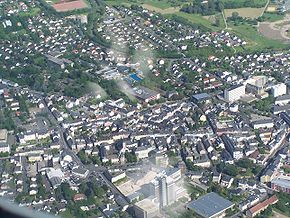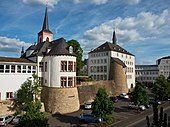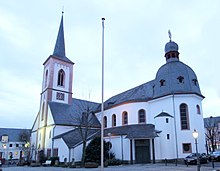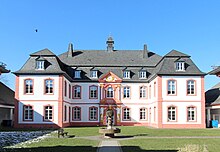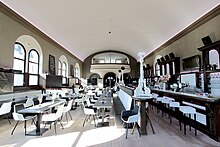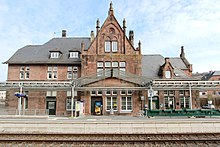Bitburg
| coat of arms | Germany map | |
|---|---|---|

|
Coordinates: 49 ° 58 ' N , 6 ° 32' E |
|
| Basic data | ||
| State : | Rhineland-Palatinate | |
| County : | Eifel district Bitburg-Prüm | |
| Height : | 339 m above sea level NHN | |
| Area : | 47.53 km 2 | |
| Residents: | 15,047 (Dec 31, 2019) | |
| Population density : | 317 inhabitants per km 2 | |
| Postal code : | 54634 | |
| Area code : | 06561 | |
| License plate : | BIT, PRÜ | |
| Community key : | 07 2 32 018 | |
| LOCODE : | DE BIT | |
| Website : | ||
| Mayor : | Joachim Kandels ( CDU ) | |
| Location of the city of Bitburg in the Eifelkreis Bitburg-Prüm | ||
Bitburg ( Moselle Franconian Bebuersch / Beburig , Luxembourgish Béibreg ) is the district town of the Eifelkreis Bitburg-Prüm in Rhineland-Palatinate and the administrative seat of the Bitburger Land association . Over 10,000 people live in the (core) city, around 3,600 other people live in parts of the city of Bitburg.
geography
Geographical location
The city is located about 30 kilometers north of Trier in the so-called Bitburger Gutland , which is part of the southern Eifel .
City structure
The districts with the other districts / residential areas are:
- Bitburg with sawmill Christiansmühle, Forsthaus Bedhard, Königswäldchen, Pützhöhe and Steinebrück
- Erdorf
- Irsch
- Masholder
- Matzen with Anwändershof, Kempenhof, restaurant and Villa Sonnenhof and forest settlement
- Mötsch with Albach
- Stahl with Backesmühle, Wingertsberg and Auf Büchelsbach
Location of the districts and neighboring communities
| Bitburg reservoir , Rittersdorf | Nattenheim , Fließem , Pützhöhe | Matzen , Irsch , Erdorf |
| Christiansmühle, Oberweis , Stahl |

|
Mötsch , Hüttingen an der Kyll , Metterich , Gondorf |
| Masholder , Messerich , Wolsfeld | Esslingen , Meckel , Idesheim | Bitburg Airport , Röhl , Speicher |
climate
The annual precipitation is 794 mm. Precipitation is in the middle third of the measuring points of the German Weather Service . 62% indicate lower values. The driest month is April; it rains most in November. In the wettest month there is around 1.5 times more rain than in the driest month. The seasonal fluctuations in precipitation are in the lower third. In just 1% of all places, the monthly precipitation fluctuates less.
history
Stone axes from the Neolithic Age have been found in the Mötsch and Masholder districts , but no permanent settlement in the Bitburg area has yet been proven. Bitburg, about a day's march north of Trier , was founded about 2000 years ago as a rest stop on the traffic axis from Lyon via Metz and Trier to Cologne . The first traditional name is Vicus Beda . "Beda" is derived from the Latin word "Betula" = "birch". Bitburg was the "Birkendorf" or - in later times - the "Birkenburg".
Around 330, at the time of Emperor Constantine , the settlement was expanded into a street fort, which still forms the city center today. The oldest recorded mention of the place name "Beda" can be found on the "Peutinger map" ( Tabula Peutingeriana ) from the 4th century. The oldest surviving documentary mention of Bitburg comes from around 715 as "castrum bedense". In the 8th century there was a Villa Regia of the Franconian kings and Bitburg was also the capital of an extensive district , the Bidgau . In the middle of the 10th century the city became part of the county of Luxembourg (later duchy).
The first important event in Bitburg's history was the Trier-Luxembourg treaty between Archbishop Theoderich II of Trier and Countess Ermesindis of Luxembourg , which was signed in 1239. Bitburg was first referred to as a city , the archbishop largely waived his claims to Bitburg and the Luxembourgers undertook to fortify the city. Henry the Blonde , the son of Ermesindis, Bitburg awarded the in 1262 town charter :> On behalf of the Holy and Indivisible Trinity. Heinrich, Count of Luxembourg and Laroche, Margrave of Arlon . We want all believers in Christ, present and future, to know that in our endeavor to ensure peace and tranquility for our citizens of Bitburg, we have decided to grant them the privilege of freedom. ‹This freedom gave citizens and lay judges the right to elect one of their own as judge, to hold their own court, to set their own weights and measures, to use the pastures, waters and forests of the city and to guard the city.
In 1443 Bitburg passed to the county of Burgundy . Since 1506 the place belonged first to the Spanish , from 1714 to the Austrian Netherlands.
There are only a few documents on the history of Bitburg from the early modern period. One of the most important are the so-called 'Schweisdal Chronicles', the chronicle of the Schweisdal and Scholer families in Bitburg, which consists of authentic diary entries from the beginning of the 17th to the beginning of the 18th century. The only original sources on the Thirty Years' War in Bitburg can be found here, at least for the last years of the war. The original of the chronicle is in the State Archives in Luxembourg, copies are owned by the City of Bitburg and the Bitburg-Prüm District Museum .
In 1676 the city was conquered for the first time (by the French) and the city walls were destroyed. In 1794, the city came under French administration and in 1795 became the capital of a canton of the Forêts department (Département des Forêts). This was followed by a short period of upswing, especially the administration was massively built up. Bitburg received a. a. a court and a cadastral office . Bitburg came to the Kingdom of Prussia in 1815 through the resolutions of the Congress of Vienna , where it was administratively part of the Lower Rhine Province as a district town until 1822 , then to the Rhine Province .
In 1805 a meteorite weighing about 1.5 tons was found near Bitburg . It belongs to the IAB class of iron meteorites . Since the attempt was made to melt the meteorite, hardly any original material has survived today.
On December 24, 1944, towards the end of the Second World War , 85 percent of Bitburg was destroyed by air raids and officially declared a “dead city” by the Americans. Bitburg then belonged to the French zone of occupation . The Luxembourg army stationed from 1945 to 1955 a garrison in in the 30s for the Wehrmacht built barracks, which was then used by the French army until the 1984th A NATO base under US leadership was added in 1953 . Between 1945 and 1955, Luxembourg soldiers were also stationed as an allied occupation force in Bitburg and Neuerburg . In 1985 the French armed forces withdrew from Bitburg and NATO took over their former barracks. After the end of the Second Gulf War , the 525th Tactical Fighter Squadron, "Bulldogs", was initially disbanded, the 53rd Tactical Fighter Squadron, "Tigers", moved to the nearby base in Spangdahlem in 1994 , the 22nd TFS "Stingers" disbanded and finally on 30. September 1994 the NATO airfield Bitburg with its 36th TFW completely shut down. Today only the "housing" and parts of the barracks in Bitburg are used by NATO. A total of 2,216 American soldiers and their relatives still lived (as of June 30, 2007) in the "Housing" or the Bitburg city area. The US Army intends to give up the housing district by 2018 [obsolete] and return it to the city of Bitburg. The airfield was returned to the city of Bitburg in 1994 and converted into a leisure and commercial area with a commercial airfield.
On June 7, 1969, as part of the regional reforms in Rhineland-Palatinate, the previously independent municipalities of Erdorf, Irsch, Masholder, Matzen, Mötsch and Stahl were incorporated into Bitburg.
In 1985, Bitburg came into the public eye for a few days when US President Ronald Reagan and Federal Chancellor Helmut Kohl were guests and visited the "Kolmeshöhe" military cemetery. In addition to around 2,000 soldiers from the First and Second World War, members of the Waffen SS are buried here ( Bitburg controversy ).
- Statistics on population development
The development of the population of Bitburg, the values from 1871 to 1987 are based on censuses:
|
|
religion
-
Catholic parishes :
- St. Peter Bitburg with St. Nikolaus Mötsch and St. Firminus, Quirinus and Ferrutius Masholder
- St. Laurentius Erdorf
- Liebfrauen Bitburg with St. Donatus Matzen and St. Wolfgang / St. Lucia steel
- Bitburg Evangelical Church
- Evangelical Free Church Congregation ( Baptists )
- International Baptist Church
- New Apostolic Church
- St. Athanasius Church of the Copts
- Jehovah's Witnesses
- Islam - Bitburg Mosque
- Jews - Bitburg Synagogue
politics
City council
The city council in Bitburg consists of 28 council members who were elected in a personalized proportional representation in the local elections on May 26, 2019 , and the full-time mayor as chairman.
The distribution of seats in the city council:
| choice | SPD | CDU | AfD | FDP | GREEN | FBL | LS | total |
|---|---|---|---|---|---|---|---|---|
| 2019 | 5 | 7th | 0 | 2 | 4th | 5 | 5 | 28 seats |
| 2014 | 4th | 8th | - | 1 | 5 | 5 | 5 | 28 seats |
| 2009 | 3 | 8th | - | 2 | 3 | 5 | 7th | 28 seats |
| 2004 | 4th | 9 | - | 1 | 2 | 4th | 8th | 28 seats |
- FBL = Free Citizens List Bitburg e. V.
- LS = dispute list e. V.
mayor
- 1797–1800 Johann Schausten
- 1800–1813 Matthias Well
- 1813–1823 Franz Sales Zangerlé
- 1824–1836 Johann Baptist Well
- 1836–1841 Carl Rudorff
- 1841–1847 Nikolaus Well
- 1848 Carl Coupette
- 1850–1851 Stephan Schieber
- 1851 Franz Hisgen
- 1851–1854 Nikolaus Weiand
- 1854–1860 Wilhelm Stucker
- 1860–1880 Hubert Prim
- 1880-1892 Wilhelm Stucker
- 1897–1902 Matthias Schrömbgens
- 1902–1917 Albert Neß
- 1917–1927 Richard Messerich
- 1927–1934 Otto Fröhlich
- 1934–1937 Ernst Diedenhofen
- 1937–1944 Rudolf Obé
- 1945 Friedrich Weber
- 1945 Kaspar Thielen
- 1945–1946 Jakob Mölbert
- 1946–1949 Josef Niederprüm
- 1949–1959 Franz Hankeln
- 1959–1961 Heinz Villinger
- 1962–1971 Wilhelm Kreutzberg
- 1971–1977 Hans Peter Lafrenz
- 1978–1987 Theo Hallet
- 1987–1997 Horst Büttner
- 1997–2009 Joachim Streit
- since December 16, 2009 Joachim Kandels
In the direct election on September 24, 2017, Joachim Kandels was confirmed in office for a further eight-year term with a share of 51.9% of the votes.
Coat of arms, banner and flag
| Blazon : “In red a golden (yellow) gate crowned with three battlements on a square base, each bordered by a five-pointed golden (yellow) star over a golden (yellow) nailed cross ; in the upper coat of arms a three-towered silver (white) wall crown with a closed gate. " | |
| Justification of the coat of arms: The coat of arms designed by Otto Hupp in 1909 refers to seals that can be traced back to 1248. The tower and castle are not only symbols of a town in the area, but also references to an old castle and the town's name. |
Banner: blue-yellow-red in a ratio of 1: 1: 1, striped lengthways.
Hoisted flag: blue-yellow-red in a ratio of 1: 1: 1, cross-stripes with the coat of arms in the middle of the cloth.
Twin cities
| Shelbyville |
|
United States | since 1962 |
| Diekirch |
|
Luxembourg | since 1962 |
| Arlon |
|
Belgium | since 1965 |
| Rethel |
|
France | since 1965 |
| Bad Köstritz |
|
Germany | since 1992 |
Culture and sights
Theaters and museums
- The Bitburg-Prüm District Museum is located in the building of the old agricultural school from 1882 . The local history museum offers an insight into the history of Bitburg and the Eifel through numerous exhibits . Contemporary art is also exhibited in regular special exhibitions.
- The Fritz von Wille Museum is located in the Haus Beda cultural center , which is supported by the Dr. Hanns Simon Foundation . The Düsseldorf painter Fritz von Wille (1860–1941) is the most important and most famous painter in the Eifel. In the newly designed museum rooms, around 100 paintings and drawings from all creative phases provide a representative overview of Willes' life and work, including major works such as The Blue Flower , Mosenberg , Reifferscheid Castle in Winter and A Clear Day .
- A 1700 m² brand and adventure world of the Bitburger brewery around the world-famous beer.
Buildings
- Remains of the Roman and medieval fortifications have been preserved on the Roman wall . After the war, attempts were made to faithfully rebuild the old city wall near the town hall. An old city tower was integrated into the newly built town hall.
- Schlösschen, a three-wing building with a mansard hipped roof from 1764
- Old brewhouse with beer fountain from 1937 by Carl Burger
- Former gym from 1911 at Trierer Straße 11. The building was converted into a restaurant in 1999.
- Former house from 1887 on the Roman wall 1
- Ground plan replica of the Cobenturm from the 16th century in the pedestrian zone
- Residential and commercial building from 1914 at Trierer Strasse 26
- Burgmühle - a former mill west of the city from 1821 with a water wheel and oven.
See also: List of cultural monuments in Bitburg
Green spaces and recreation
- The Bitburg Sculpture Cycle Path was created in 2003 at an international sculpture symposium . It leads from Bitburg via Irrel to Steinheim in Luxembourg and is part of the Rhineland-Palatinate Sculpture Trail .
- Forest adventure trail Königswäldchen ⊙
- The archaeological circular route "Roman Bitburg" offers an excellent impression of the former road fort on 16 stations.
- Devil's Gorge near Bitburg-Irsch ⊙
- Natural Monument Alpbachtal - Albachmühle and Marie Grotto in Alpbachtal, limestone gorge with wooded slopes east of Bitburg ⊙
- The municipal war cemetery Kolmeshöhe comprises around 2000 graves. ⊙
See also: List of natural monuments in Bitburg
Regular events
- The city first invited folk dance and majorette groups , music clubs, minstrels and fanfare parades to Bitburg for the 1250th anniversary in 1965 . The success of this festival prompted the organizers to organize an annual European folklore festival. The festival called “European Borderland Meeting” at the beginning was renamed to “European Folklore Festival” in the early 1990s, as dance and folklore groups from outside Europe also took part. Today the festival is one of the largest folklore events in Germany. It takes place annually on the second weekend in July with around 50 groups from more than 15 countries.
- The Beda market has been held annually on the third weekend in March in the Bitburg city area since 1967.
- The autumn fair with fireworks takes place on the first weekend in November on Bedaplatz.
- The traditional hut burning on the first weekend after Ash Wednesday (so-called Scheef Sunday) takes place in all of Bitburg's districts
- The Gäßestrepper festival always takes place on the first Sunday of September in St. Peter's Square. It is based on the legend of the medieval alley staircase .
Economy and Infrastructure
economy
The best-known company and landmark of the city is the Bitburger brewery .
The former NATO base near Bitburg has been converted into an industrial and commercial area of around 500 hectares since around 1995 under the name of “Gewerbepark Flugplatz Bitburg ” . 180 companies have now settled there. According to letters of intent from investors, civil flight operations are to be further expanded over the next few years. According to information from the investors, planes are to take off there for Eastern Europe . However, this project is very controversial and was rejected by the federal government at the request of the Greens; therefore the future of the airfield remains unclear, because there is also another group of investors who want to develop this airfield into a solar park . These plans were expressly welcomed by the federal government.
Bitburg is a designated and only medium-sized center in the southern Eifel district of Bitburg-Prüm. The central location has long created a diverse range of trade and services.
traffic
air
The airfield Bitburg (IATA BBJ, ICAO EDRB) is an airfield with night flight permission Bitburg in the region Trier. It was a US Air Force military airfield during the Cold War and was called Bitburg Air Base. It is operated by Flugplatz Bitburg GmbH from the districts of Bernkastel-Wittlich, Bitburg-Prüm, Trier-Saarburg, the city of Trier and the Vulkaneifel Daun economic development company, as well as the Trier Chamber of Commerce and Industry .
Street
The B 51 is the important north-south connection; As the successor to the Roman road Trier – Cologne, it connects the Trier and Luxembourg area with the north. The place is on the old Roman road Trier-Neuss . For a few years now, the A 60 has been running from Lüttich (Liège) to Wittlich . The once disadvantageous German peripheral location is gradually becoming a central European location.
The trial period of a planned inner city ring began in autumn 2013. However, this was so strongly criticized by the population and retailers that it was completely dismantled on March 30, 2015.
rail
The Bitburg-Erdorf station is located at the Eifel track Cologne - Euskirchen - Gerolstein - Trier and is the only passenger station of Bitburg. It is about 6 kilometers away by road and about 100 meters lower than Bitburg city center. The bus line 405 connects the central bus station ZOB with the train station in the Erdorf district several times a day.
The tariff of the Verkehrsverbund Region Trier (VRT) applies to all local public transport (ÖPNV ) .
In Bitburg-Erdorf the Nims-Sauertalbahn branches off to Bitburg (city train station in Bitburg-Süd); the tracks end today at the level of the Bitburg brewery south. The railway line originally ran via Irrel to Igel and was built from 1910. After the decline in transport services since the 1960s, the single-track branch line was shut down and dismantled in several sections, the last section Wolsfeld - Bitburg in 1997. There is no scheduled traffic on the remaining six-kilometer stretch of Erdorf - Bitburg (city). Passenger traffic in Bitburg (city) station was discontinued in 1970 (and switched to buses). The remaining stretch is now owned by Amprion (electricity network operator) and is in this respect a private siding, via which primarily transformers etc. for the Niederstedem substation are transported to and from the Niederstedem substation by rail.
In the urban area, in addition to Bitburg-Erdorf and Bitburg (city), there was a Masholder stop southwest of the latter station until 1970 .
Sports
The most successful sports club in Bitburg is the soccer club FC Bitburg , whose greatest success was winning the Rhineland Cup in the 1987/88 season and the associated qualification for participation in the DFB Cup . Today the club plays in the district league West Rhineland (2016/2017). The women's team that played in the Regionalliga Südwest for a long time is more successful . Ice hockey is also one of the more successful sports . When the ice sports club Bitburg was founded in 1978 , its 1st team took part in the then third-class 2nd ice hockey league in 1994/95 . In 2014 the ice sports club was dissolved and the Bitburg ice sports club was founded in its place. Another larger club is TC Bitburg, which operates a tennis court in the north of the city. The city is also home to TV Bitburg, which offers a wide range of sports. The basketball players in the department were particularly successful, winning the German B youth championship in 1998 and producing Martina Weber, a WNBA player and German national team player. The men's handball team of TV Bitburg rose to the Oberliga Rheinland-Pfalz / Saar for the third time in the 2015/2016 season.
education
Day care centers
- St. Peter day care center
- Daycare center Liebfrauen
- Bitburg-Mötsch daycare center
- Daycare center Altes Gymnasium
- Zuckerborn municipal day-care center
schools
- Bitburg-Süd elementary school
- Bitburg-Nord elementary school
- Primary School St. Matthias (Catholic)
- Cooperative Comprehensive School St. Matthias (Catholic)
- Realschule plus Bitburg (Otto Hahn Realschule)
- St. Willibrord Gymnasium (MINT-EC school with a bilingual profile)
Special schools
- St. Martin School
- Maximin School
Vocational schools
- European Vocational Training Center Bitburg
- Eifel Rural Service Center (DLR)
- Theobald Simon School
Personalities
Honorary citizen
Born in Bitburg
- Charles-Mathias Simons (1802–1874), Luxembourg lawyer and politician
- Johann August Messerich (1806–1876), lawyer, member of the Prussian National Assembly in 1848
- Nikolaus Thilmany (1806–1885), Prussian administrative officer and district administrator of the Bitburg district, and first honorary citizen of the city of Bitburg
- Peter Wallenborn (1848–1917), member of the Reichstag and Landtag, honorary citizen from 1913
- Heinrich Hildebrand (1855–1925), railway engineer
- Hermine Albers (1894–1955), co-founder of the working group for youth care and welfare and co-editor of the magazine Our Youth
- Wilhelm Fuchssteiner (1908–1982), civil engineer
- Hanns Simon (1908–1989), entrepreneur and brewer
- Georg Sigmund Adelmann von Adelmannsfelden (1913–1991), art historian, President of the Baden-Württemberg State Monuments Office
- Wilhelm Semmelroth (1914–1992), director
- Bernd Krewer (* 1939), forester, hunting cynologist and non-fiction author
- Axel Th. Simon (1943–2018), entrepreneur and brewer
- Jean-Marc Barr (* 1960), French actor, director, film producer and screenwriter
- Stefan Hippler (* 1960), pastor in Cape Town
- Birgit Zeimetz-Lorz (* 1960), politician (CDU)
- Hans Jürgen Pütsch (* 1961), local politician (CDU), Lord Mayor of Rastatt
- Linda Somers Smith (born 1961), American long-distance runner
- Rainer Hoffmann (* 1962), politician (PDV)
- Martin Lejeune (* 1964), jazz musician
- Norbert Thüx (* 1964), Prior of the Teutonic Order
- Patrick Schlösser (1971–2017), theater director
- Scott Elrod (* 1975), American actor
- Alex Goolsby (born 1987), basketball player
Connected to Bitburg
- Johann Peter Wallenborn (1784–1839), brewer and landowner; founded the Bitburger brewery in 1817 "in front of the Schaakentore" .
- Karl Vogt (1915–1997), District Administrator from 1962 to 1979
- Buzz Aldrin (* 1930), was the second person to walk on the moon as part of the Apollo 11 mission; he was stationed in Bitburg for about three years.
- Tomasz Niewodniczański (1933–2010), patron and regional historian
- Günther Thömmes (* 1963), brewer and writer, grew up in Bitburg.
- Marcus Dahm (* 1977), composer, church musician & musicologist, grew up in Bitburg.
literature
Non-fiction books
sorted alphabetically by author / publisher
- Working group for regional history and folklore of the Trier area in connection with the city of Bitburg, Richard Laufner: History of Bitburg . 1965.
- Bernd Altmann, Hans Caspary: Bitburg-Prüm district. City of Bitburg, Verbandsgemeinden Bitburg-Land and Irrel (= cultural monuments in Rhineland-Palatinate. Monument topography Federal Republic of Germany . Volume 9.2 ). Wernersche Verlagsgesellschaft, Worms 1997, ISBN 3-88462-132-7 .
- Emil Meynen: The Bitburger Land . Engelhorn, Stuttgart 1928. (Dissertation at the University of Cologne 1926).
- Ernst Wackenroder (arr.): The Art Monuments of the Bitburg District (= The Art Monuments of the Rhine Province . Volume 12 / I ). Trier 1983, ISBN 3-88915-006-3 , p. 45–69 (reprint of the Schwann edition, Düsseldorf 1927).
- Kulturgemeinschaft Bitburg (ed.): Bitburg . 2nd Edition. 2001, DNB 1063011310 .
- Marie Luise Niewodniczanska: City of Bitburg in the Eifel . Rhenish Association for Monument Preservation and Landscape Protection, Cologne 1993, ISBN 3-88094-746-5 .
- Michael Berens: Churches and chapels in Bitburg . In: Geschichtlicher Arbeitskreis Bitburger Land (Ed.): The churches and chapels of the Bitburger Land (= contributions to the history of the Bitburger Land . No. 8/9 ). 1992, DNB 941111199 , p. 18 ( gak-bitburg.de [PDF; accessed on June 16, 2017]).
- Peter Neu: Bitburger personalities. Bitburg 2006.
Fiction
- Günther Thömmes: The beer magician. Historical novel . 6th edition. Gmeiner, 2008, ISBN 978-3-89977-746-8 .
- Günther Thömmes: The curse of the beer wizard. Historical novel . 2nd Edition. Gmeiner, 2010, ISBN 978-3-8392-1074-1 .
Web links
- Official website of the city
- The Franconian Bitburg from the conquest to the end of the Merovingians (475 to 751)
- Link catalog on Bitburg at curlie.org (formerly DMOZ )
- To search for cultural goods of the city of Bitburg in the database of cultural goods in the Trier region .
Individual evidence
- ↑ State Statistical Office of Rhineland-Palatinate - population status 2019, districts, communities, association communities ( help on this ).
- ↑ State Statistical Office Rhineland-Palatinate (ed.): Official directory of the municipalities and parts of the municipality. Status: January 2018 [ Version 2020 is available. ] . S. 59 (PDF; 2.2 MB).
- ↑ On the origin of the name: Stephan Hormes, Silke Preust: Atlas of true names . Carlsen Verlag, Hamburg 2009.
- ↑ Bitburg. Meteoritical Bulletin, accessed June 5, 2020 .
- ↑ Thomas Witzke: Meteorite from Germany. strahlen.org, accessed June 5, 2020 .
- ↑ Bitburg city administration is looking for contemporary witnesses: Who still remembers the Luxembourg garrison? In: volksfreund.de . June 10, 2015, accessed July 15, 2019 .
- ↑ Bitburg's new district has to wait. In: Trierischer Volksfreund. January 6, 2010.
- ↑ Official municipality directory (= State Statistical Office of Rhineland-Palatinate [Hrsg.]: Statistical volumes . Volume 407 ). Bad Ems February 2016, p. 160 (PDF; 2.8 MB).
- ↑ State Statistical Office Rhineland-Palatinate - regional data
- ^ Website of the Coptic community , article in Trierisches Volksfreund
- ^ The regional returning officer RLP: City council elections 2019 Bitburg. Retrieved August 15, 2019 .
- ^ Trierischer Volksfreund: Joachim Kandels remains in office with 51.9 percent. September 24, 2017. Retrieved December 15, 2019 .
- ^ Entry on the seal and coat of arms of Bitburg in the database of cultural assets in the Trier region ; accessed on September 15, 2015.
- ↑ German municipal flags
- ↑ Königswäldchen forest adventure trail. Retrieved April 3, 2018 .
- ↑ Bitburg Archaeological Circuit. Retrieved April 3, 2018 .
- ↑ Hüttenbrennen in the Eifel. Retrieved May 1, 2016 .
- ↑ Hut Sunday in the Eifel. Retrieved August 10, 2017 .
- ↑ Gäßestrepper Festival | Eifel traditions & legends | Service information | Vacation Bitburger Land . In: www.eifel-direkt.de . ( eifel-direkt.de [accessed on September 3, 2018]).
- ↑ Alternative airport for the Findel. In: Luxemburger Wort. November 2, 2009.
- ↑ Handball: TV Bitburg celebrates the league promotion - relegation falls flat because of cancellations. In: volksfreund.de. Retrieved April 29, 2016 .
- ↑ a b facilities. City of Bitburg, accessed on February 13, 2015 .



